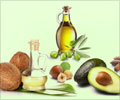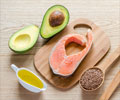Good Fats and the Bad Fats
Saturated fat is bad fat and Monounsaturated
We are very much aware of the fact that different foods contain many different types of fats which can be described as either good or bad fats. The cooking fat or oil is made up of fatty acids. Let us briefly go over this before understanding the more practical and doable dietary shifts which takes us towards a low saturated fat and a low cholesterol food diet.
Saturated Fats/ Fatty acids are usually solid in nature and the body uses them to produce other really bad fats called LDL cholesterol. Ghee and coconut oil contain
Unsaturated fats/Unsaturated fatty acids are usually liquid in nature. They are divided into two broad categories,
Monounsaturated fatty acids have a beneficial effect by lowering
Polyunsaturated fatty acids can be classified as omega-3 and omega-6 fatty acids. Since they cannot be synthesized in the body they must be obtained through diet. That is why they are known as essential fatty acids
They serve as raw material to produce a number of regulatory substances called prostaglandins, which help in lowering bad cholesterol, maintaining blood pressure and are heart protective. Oils rich in omega-6 fatty acids are safflower and sunflower oil. Oils rich in omega-3 fatty acids are soybean, mustard, rice bran and sesame oil. Cooking fat/oil is the visible source of fat whereas the fat that comes from the food we eat is the invisible source.
Omega-3 fatty acids have far greater benefit than omega-6 fatty acids. Omega-6 fatty acids are available in plenty in a variety of foods and therefore we can easily meet the daily requirement for the same. However omega-3 has varied health benefits and at the same time it is present only in selected foods and oils.
Cholesterol is essential for life. It is found in every living creature but mostly in animal fats. Cholesterol performs many vital functions and is an important component of the cell membrane. Surprisingly, all cholesterol is not bad. Some of it is naturally produced by the body (and can be affected by the family health history); while some of it comes from the food that we eat. There are two types of cholesterol – LDL and HDL. LDL cholesterol can lead to plaque formation on the artery walls. With more LDL in the blood, the risk of heart disease increases. Foods high in cholesterol are
Too much cholesterol in the blood is a major risk for coronary heart disease and stroke. A variety of factors such as heredity, age, gender, diabetes, diet and weight can affect the cholesterol level. Diet is the only factor which is under our control. Saturated fat and cholesterol in the food we eat increases cholesterol levels. To keep obesity, diabetes, high cholesterol, metabolic syndrome, at bay we have to strive to reduce the amount of saturated fat and cholesterol in our diet.
Saturated fats and persistently high cholesterol levels are linked to many diseases and conditions. There are no bounds to their destructive effects.


















